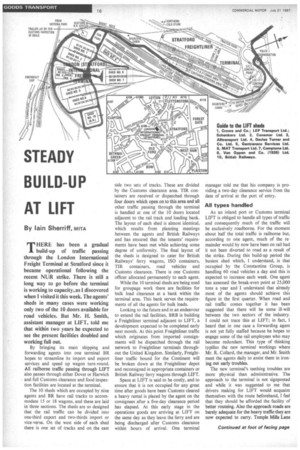STEADY BUILD-UP AT LIFT
Page 18

If you've noticed an error in this article please click here to report it so we can fix it.
By lain Sherriff, MITA THERE has been a gradual build-up of traffic passing through the London International Freight Terminal at Stratford since it became operational following the recent NUR strike. There is still a long way to go before the terminal is working to capacity, as I discovered when I visited it this week. The agents' sheds in many eases were working only two of the 10 doors available for road vehicles. But Mr. H. Smith, assistant manager at LIFT, told me that within two years he expected to see the present facilities doubled and working full out.
By bringing its main shipping and forwarding agents into one terminal BR hopes to streamline its import and export services and speed up wagon turn-round. All railborne traffic passing through LIFT also passes through either Dover or Harwich and full Customs clearance and food inspection facilities are located at the terminal.
The 10 sheds which are occupied by nine agents and BR have rail tracks to accommodate 15 or 18 wagons, and these are laid in three sections. The sheds are so designed that the rail traffic can be divided into one-third export and two-thirds import or vice-versa. On the west side of each shed there is one set of tracks and on the east
side two sets of tracks. These are divided by the Customs clearance area. TIR containers are received or dispatched through four doors which open on to this area and all other traffic passing through the terminal is handled at one of the 10 doors located adjacent to the rail track and loading bank. The layout of each shed is almost identical, which results from planning meetings between the agents and British Railways and has ensured that the tenants' requirements have been met while achieving some degree of uniformity. The final layout of the sheds is designed to cater for British Railways' ferry wagons, ISO containers, TIR containers, road vehicles and Customs clearance. There is one Customs officer allocated permanently to each agent.
While the 10 terminal sheds are being used for groupage work there are facilities for bulk load clearance at a bank within the terminal area. This bank serves the requirements of all the agents for bulk loads.
Looking to the future and in an endeavour to extend the rail facilities, BRE is building a Freightliner terminal adjacent to LIFT, a development expected to be completed early next month. At this point Freightliner traffic which originates from imported consignments will be dispatched through the rail network to Freightliner terminals throughout the United Kingdom. Similarly, Freightliner traffic bound for the Continent will be broken down at the Freightliner depot and reconsigned in appropriate containers or British Railway ferry wagons through LIFT.
Space at LIFT is said to be costly, and to ensure that it is not occupied for any great time after goods have been Customs cleared a heavy rental is placed by the agent on the consignees after a five-day clearance period has elapsed. At this early stage in the operations goods are arriving at LIFT on the same day as they leave the ferry and are being discharged after Customs clearance within hours of arrival. One terminal manager told me that his company is providing a two-day clearance service from the date of arrival at the port of entry.
All types handled
As an inland port or Customs terminal LIFT is obliged to handle all types of traffic and consequently much of the, traffic will be exclusively roadborne. For the moment about half the total traffic is railborrie but, according to one agent, much of the remainder would by now have been on rail had it not been diverted to road as a result of the strike. During this build-up period the busiest shed which, 1 understand, is that occupied by the Constantine Group, is handling 60 road vehicles a day and this is expected to increase each week. One agent has assessed the break-even point at 25,000 tons a year and I understand that already most of the agents should achieve this figure in the first quarter. When road and rail traffic comes together it has been suggested that there will be some ill-will between the two sectors of the industry. I could not trace this at LIFT; in fact, I heard that in one case a forwarding agent is not yet fully staffed because he hopes to engage some of the rail employees who may become redundant. This type of thinking typifies the new terminal workings where Mr. R. Collard, the manager, and Mr. Smith meet the agents daily to assist them in ironing out early troubles.
The new terminal's teething troubles are more physical than administrative. The approach to the terminal is not signposted and while it was suggested to me that drivers making for LIFT would acquaint themselves with the route beforehand, I feel that they should be afforded the facility of better routeimg. Also the approach roads are barely adequate for the heavy traffic they are now expected to carry. Temple Mills Lane












































































































